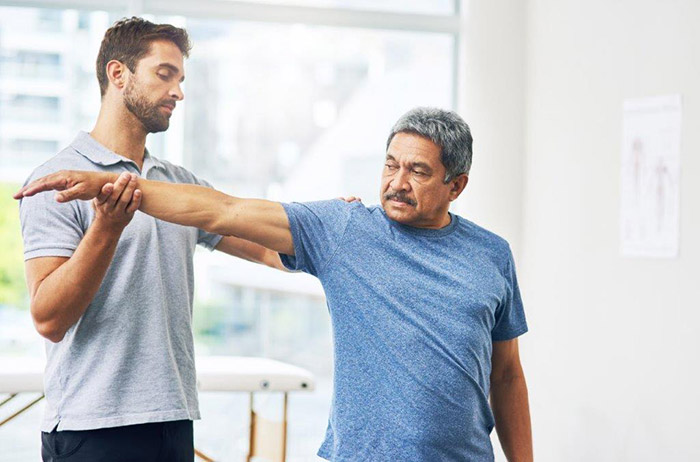

 By - Namrata Gupta Functional Manual Therapist at VARDĀN |
| Ever wondered, why your shoulder or neck feels stiff, even though your doctor says that your neck or shoulder look absolutely fine on imaging. Well, the answer might lie in your ribcage. Infact, ribcage can be rightly called as the connecting link between our upper body and the lower quarter of body. Let’s try to understand it better!! |
| The rib cage– also known as the thoracic cage, is the arrangement of 24 ribs attached to the spine at the back and chest bone (sternum) in the front. This encloses and protects the heart and lungs. |
|
Protection: It encloses and protect vital organs like heart and lungs. Respiration (breathing): When we inhale ribs move up (elevate), when we exhale ribs move down (depress). All major muscles of respiration for eg diaphragm are attached to the ribcage which helps it to move. Movement: There are small / tiny amounts of movement available at joints between ribs to the spine and with chest bone. Although these moments are very small but very imperative for functioning of our neck, shoulders and trunk. |
| An open/flexible ribcage is vitally important if you are going to do anything overhead, say a tennis serve or to just pick up things from overhead shelf. If your ribs are restricted in movements, this can have a direct influence on how much your shoulders are able to extend and open. The ability of shoulders to open and have free range of motion (ROM) not only depends on flexibility at shoulders itself but also in the ribcage. |
| Shoulders are connected to our trunk through shoulder blades which sits directly onto this cage like structure formed by ribs. This biomechanical connection between shoulder joint and ribcage allows each to affect the function of other, which at times manifest itself as pain and limited ROM. |
| Similarly, our ribcage lies right underneath our head and neck, which implies biomechanically that ribcage serves as base for our neck to sit on, which further implies that they can influence each other’s function. At times, neck stiffness and headaches symptoms, especially postural in origin, are due to ribcage not free or flexible enough. |
|
Training of core has become hugely popular in fitness industry. According to Kibler, core stability is ability to control the position and motion of the trunk and pelvis over our lower body. This in simple terms mean that proximal stability sets the stage for distal mobility. Many rehab experts would agree that diaphragmatic breathing is most fundamental demonstration of core function. And guess, where our diaphragm lies in our body. Well, at the base of the ribcage, encased all around by the ribcage, having intricate attachments to the ribcage.
So, if you are training hard for core but not paying attention to your ribcage, diaphragm and breathing pattern. You are definitely missing a big chunk of it! Symptoms due to ribcage dysfunctions are:
|

| FMTTM is an approach based on human body function and we restore the same using manual therapy i.e. hands on treatment. One of the important pillars of this approach is mechanical restrictions. Mobility restrictions around ribcage can be very effectively treated through this approach. We also offer customized exercise program for core strengthening keeping in mind efficient breathing patterns, thus including diaphragm and ribcage into it. Breathing With efficiency can help people in improving their performances in sports as well as daily functions. |

| Our Client Speak I was treated by Namrata and not a day goes by that I don’t think of her and VARDĀN during this lockdown. I wonder each day that had I not visited VARDĀN and met Namrata and had she not treated me with so much love, care and patience, I would have surely not made it through in this time of lockdown. Today I can proudly say that I am able to manage my house (which by god’s grace is a big independent duplex house) my family of four - my husband, two teenage kids and me and my kitchen, without any pain in my legs and back. I just do the basic exercises that Namrata taught me in the SUPEX Sessions. So, a big big thanks and special regards to you, Namrata and Team VARDĀN!! –Arti Sondhi |


|
VARDĀN is open for consultation & treatment sessions. You can book an appointment with our Functional Manual Therapist to avail our services. We are following stringent precautionary measures for your safety. To contact, you may call or mail us. |
Please call 011-43580720-22, 8:30 AM to 6:00 PM
Monday to Saturday
You may also contact our team on
+91-9971112446, +91-9910955500, +91-9810306730, +91-9910855500
Email: vardan@timesgroup.com | Web: www.vardan.in
Address: 16-A, Ring Road, Lajpat Nagar- IV, New Delhi 110024
